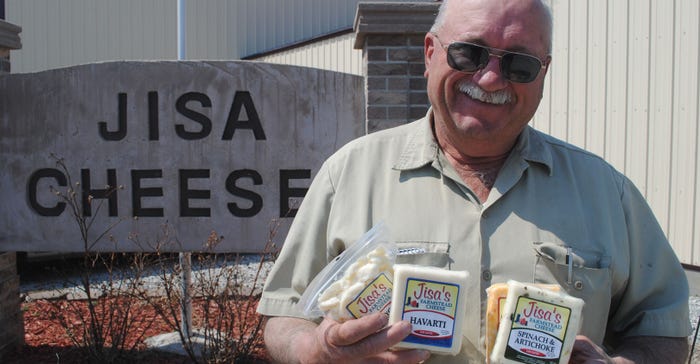
While dairy cow numbers in Nebraska have grown steadily in the past few years, there continues to be room for more dairy processing. Only a handful of processors purchase fluid milk from other dairies in the state, and a few dairies have their own on-farm processing plants.
Dave Jisa and his team at Jisa’s Farmstead Cheese near Brainard, Neb. operate an on-farm cheese plant, using the milk they produce in their family dairy to make and market unique, artisanal flavors of cheese.
Dave’s father, Lad, started the dairy in 1946 after returning home from the armed services in World War II. The dairy became Grade A in 1950. That’s the dairy Dave grew up with. So, when he began farming, the dairy was important. Although he now farms 2,500 acres, he and his family have also found a way to combat fluctuating milk prices and make their 300 Holstein milk cows continue to pay for themselves.
After consulting with experts at the University of Nebraska Food Science and Technology department, Jisa came up with a plan for their new venture into cheese making. In 2005, the Jisas built their 6,000-square-foot, on-farm cheese plant adjacent to the dairy and acquired the necessary coolers, vats and equipment. Today, Dave’s sons, David and John, are both involved in nearly every aspect of the dairy and cheese business, along with several employees. They process their own pasteurized whole-fluid milk into myriad cheese flavors they’ve developed. Who wouldn’t like Smoked Bacon, Spinach and Artichoke or Havarti? Don’t forget Garlic Parsley, California Garlic Pepper, Dill and Ranch. “Havarti Bell is probably one of our top sellers,” says Jisa.
“I came up with most of the flavors myself,” Jisa says. Julie Schmid, who worked in product development and marketing for the company for six years, also worked on developing flavors. She also worked on market development and getting the product into grocery stores. Jisa’s now has products in grocery stores across the Midwest and Great Plains states. “Our New York Cheddar Curds recently won third place from the American Cheese Society,” Jisa adds. The contest, held in Madison, Wis., consisted of more than 1,750 products from 250 companies. Jisa’s daughter, Christine, who was a UNL chemical engineering student at the time, helped make the curds for the contest.
“We know how to milk cows and take care of the dairy, but the marketing part is something we had to learn,” Jisa says. He explains that it is crucial to find a niche in the cheese market. “You can’t just make cheddar and expect to compete,” he says. “You have to develop something unique and special for your customers to build that customer base.”
To accommodate customers, Jisa’s also offers its products in various forms, including the popular “nuggets” in 8-ounce packages for the on-the-go society; block cheese in 8-ounce bars, 6-pound deli loaves and 40-pound blocks; and shredded cheese. The Jisas offer samples and test their products often, especially at farmers markets, to make sure their efforts are on the right track.
The cheese-making process takes time. Jisa’s keeps costs down by raising its own feed and forages. The Jisas milk cows twice a day and transport their milk one-half mile from the dairy to the plant. The heated milk is cooled through a series of pipes and sent to either a 10,000- or a 20,000-pound cheese vat. This is where culture and enzymes are added. After thickening, the whey is drained and separated from the curd, and special seasonings are added. The curd is placed in hoops and pressed to squeeze out more whey. Then the cheese is cut and ready for packaging. After this, the curd is vacuum-packed and cooled to 36 degrees F for storage and shipment. Extracted whey from the process is bottle-fed to the dairy’s baby calves for added nutrition.
While low milk prices prompted the idea for the cheese plant to make the dairy pay, Jisa says that the family has learned much in the past 13 years since the cheese plant was built. Marketing has been the most challenging aspect of the venture, but a growing customer base and positive feedback from loyal customers have made the business successful.
Learn more about Jisa’s Farmstead Cheese by visiting jisacheese.com.
About the Author(s)
You May Also Like






